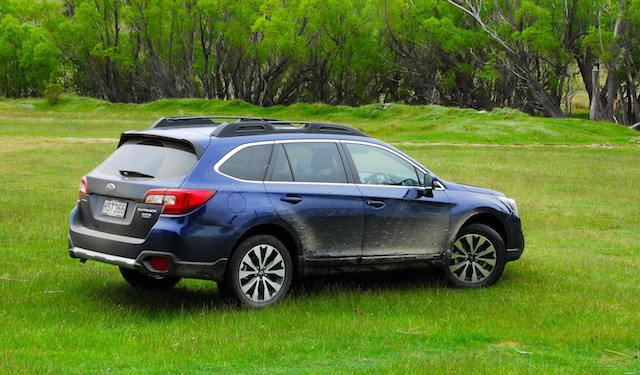
As usual, the various car of the year awards in New Zealand offered up a surprise here and there. I haven’t driven all of the cars that picked up awards or made the shortlists, but I’m picking the best out of the ones I have. Just because I can. And just because I have been writing about the motoring industry and reviewing its products since 1989. Some of my choices are new models, some are facelifts.
2015 Car of the Year
Subaru Outback: The most versatile vehicle (above) on the market – a higher-riding all-wheel-drive station wagon with car-like road manners, thanks to the Legacy sedan chassis on which the Outback is based. Classy, functional cabin. Plenty of safety stuff, including the active camera-based Eyesight system. There’s X-Mode, a crawl speed setting for slippery conditions. The continuously variable transmission (CVT) in the three Outback models is programmed to behave like an automatic with conventional torque converter. It’s the best CVT application going around. The new Outback might just be the most complete model Subaru has ever made. Line-up: Three models, three engines: 2.5-litre petrol 129kW/235Nm; 3.6-litre petrol 191kW/350kW; 2.0-litre diesel 110kW/350Nm. Priced: $44,490-$59,990.
Green Machine
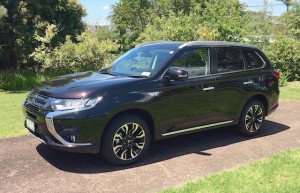 Mitsubishi Outlander PHEV. It means Plug-in Hybrid Electric Vehicle. It is not just an EV but a sensible answer to balancing convenient, every day transport with the need to reduce exhaust emissions. Nothing has been more influential in terms of the acceptance of EVs in NZ. Mitsubishi will have sold around 330-340 PHEVs by the last day of 2015. Plug it in at home overnight and it’s good for 50km on electric power alone. Go beyond 50km and it can either become a hybrid where the petrol engine works to charge the electrics, or a parallel hybrid where a management computer gets the engine and electrics to work together to drive two or all four wheels. Line-up: Two models, one better equipped than the other. Powertrain is 88kW/189Nm 2.0-litre petrol engine with twin electric motors generating 60kW/137Nm and 60kW/195Nm and plug-in battery pack. Priced: $59,990-$66,990.
Mitsubishi Outlander PHEV. It means Plug-in Hybrid Electric Vehicle. It is not just an EV but a sensible answer to balancing convenient, every day transport with the need to reduce exhaust emissions. Nothing has been more influential in terms of the acceptance of EVs in NZ. Mitsubishi will have sold around 330-340 PHEVs by the last day of 2015. Plug it in at home overnight and it’s good for 50km on electric power alone. Go beyond 50km and it can either become a hybrid where the petrol engine works to charge the electrics, or a parallel hybrid where a management computer gets the engine and electrics to work together to drive two or all four wheels. Line-up: Two models, one better equipped than the other. Powertrain is 88kW/189Nm 2.0-litre petrol engine with twin electric motors generating 60kW/137Nm and 60kW/195Nm and plug-in battery pack. Priced: $59,990-$66,990.
Compact Hatchback
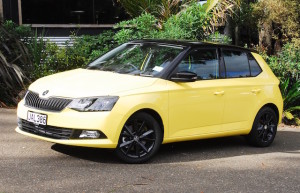 Skoda Fabia: It’s not the most dynamic five-door but it’s fun to drive. The big plus is how it squeezes so much room into its footprint, a Skoda trademark. Fabia has the biggest boot of any light hatchback, bigger than some models in the class above it. There’s a wide opening, bag hooks, and useful shelves either side.The cabin itself has more than enough room for four adults and their junk. In a nutshell, Fabia has more room everywhere than its rivals. Line-up: Five models and two 1.2-litre four-cylinder turbocharged petrol engines, one delivering 66kW/160Nm and mated to a five-speed manual gearbox; the other 81kW/175Nm and linked to a seven-speed automatic. Priced: $19,990-$26,990.
Skoda Fabia: It’s not the most dynamic five-door but it’s fun to drive. The big plus is how it squeezes so much room into its footprint, a Skoda trademark. Fabia has the biggest boot of any light hatchback, bigger than some models in the class above it. There’s a wide opening, bag hooks, and useful shelves either side.The cabin itself has more than enough room for four adults and their junk. In a nutshell, Fabia has more room everywhere than its rivals. Line-up: Five models and two 1.2-litre four-cylinder turbocharged petrol engines, one delivering 66kW/160Nm and mated to a five-speed manual gearbox; the other 81kW/175Nm and linked to a seven-speed automatic. Priced: $19,990-$26,990.
Small Hatchback
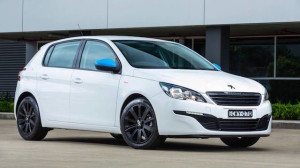 Peugeot 308: A GTi variant will launch in NZ later next month, which should throw more light on the abilities of the standard car’s chassis, as good as it is. Meantime, the 308 featured here was the European Car of the Year in 2014. It won the award largely because of its clever interior layout and its driving dynamics, centred around an all-new chassis designed to underpin future models. Peugeot knows a thing or two about building good chassis – and the 308’s platform is its best hatchback base yet. Line-up: Three models (Access, Active, Allure) three turbocharged engines, six-speed manual or ‘auto boxes: 96kW/230Nm 1.2-litre three-cylinder; 110kW/240Nm 1.6-lite four-cylinder; 110kW/370Nm 2.0-litre diesel. Priced: $32,990-$44,990.
Peugeot 308: A GTi variant will launch in NZ later next month, which should throw more light on the abilities of the standard car’s chassis, as good as it is. Meantime, the 308 featured here was the European Car of the Year in 2014. It won the award largely because of its clever interior layout and its driving dynamics, centred around an all-new chassis designed to underpin future models. Peugeot knows a thing or two about building good chassis – and the 308’s platform is its best hatchback base yet. Line-up: Three models (Access, Active, Allure) three turbocharged engines, six-speed manual or ‘auto boxes: 96kW/230Nm 1.2-litre three-cylinder; 110kW/240Nm 1.6-lite four-cylinder; 110kW/370Nm 2.0-litre diesel. Priced: $32,990-$44,990.
MEDIUM SEDAN:
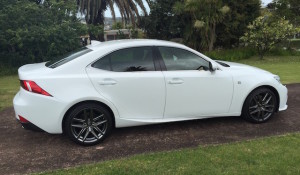 Lexus IS 200t: Good chassis but dated engine kept it behind the segment leaders; new engine and gearbox takes it up among them. The engine operates in either of two cycles – Otto for power or Atkinson for optimum fuel use. One of the best standard packages on the market. The interior is classy, if a bit fiddly in places around the centre console, and the seats are the bee’s knees. The new powertrain is what the car’s rear-drive chassis has been crying out for. The 200t will always be measured against its German rivals. Perhaps it’s time for the German stuff to be measured against the 200t. Line-up: Three models using 180kW/350Nm 2.0-litre turbocharged petrol engine mated to an eight-speed automatic. Priced: $73,900-$86,400.
Lexus IS 200t: Good chassis but dated engine kept it behind the segment leaders; new engine and gearbox takes it up among them. The engine operates in either of two cycles – Otto for power or Atkinson for optimum fuel use. One of the best standard packages on the market. The interior is classy, if a bit fiddly in places around the centre console, and the seats are the bee’s knees. The new powertrain is what the car’s rear-drive chassis has been crying out for. The 200t will always be measured against its German rivals. Perhaps it’s time for the German stuff to be measured against the 200t. Line-up: Three models using 180kW/350Nm 2.0-litre turbocharged petrol engine mated to an eight-speed automatic. Priced: $73,900-$86,400.
LARGE SEDAN
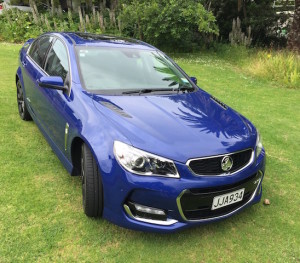 Holden VF II Commodore: The Redline SS V and its 6.2-litre V8 also qualifies for the ‘politically incorrect’ award, in that it’s a big, gutsy engine in a world of increasingly smaller engines. The VF II does what all Commodores have done – improve with each new generation. This one hasn’t necessarily made a giant leap forward, but it does something no others have managed: it disguises its size from the driver’s seat. Yep, it feels smaller and more compact on the move than it actually is. It’s a perfect final fling by Holden, an ANZAC salute to a storied badge before production of the Australian-built Commodore ends in 2017. Line-up: Eight models, three engines, six-speed manual or auto: 185kW/290Nm 3.0-litre V6; 210kW/350Nm 3.6-litre V6; 304kW/570Nm 6.2-litre V8. Priced: $49,990-$73,990.
Holden VF II Commodore: The Redline SS V and its 6.2-litre V8 also qualifies for the ‘politically incorrect’ award, in that it’s a big, gutsy engine in a world of increasingly smaller engines. The VF II does what all Commodores have done – improve with each new generation. This one hasn’t necessarily made a giant leap forward, but it does something no others have managed: it disguises its size from the driver’s seat. Yep, it feels smaller and more compact on the move than it actually is. It’s a perfect final fling by Holden, an ANZAC salute to a storied badge before production of the Australian-built Commodore ends in 2017. Line-up: Eight models, three engines, six-speed manual or auto: 185kW/290Nm 3.0-litre V6; 210kW/350Nm 3.6-litre V6; 304kW/570Nm 6.2-litre V8. Priced: $49,990-$73,990.
SMALL SUV
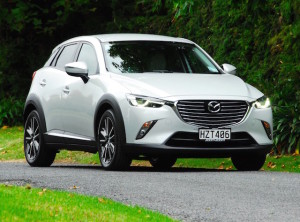 Mazda CX-3: Another example of Mazda’s SkyActiv engine, transmission, and chassis technology. I said when it was launched in April: “It will put skids under those rivals who don’t take it seriously. Two reasons: 1. because it looks so good; 2. because it is.” The CX-3 is based on the Mazda2 hatchback. It shares its sibling’s wheelbase, but is 215mm longer, 70mm wider and 55mm higher overall. Inside, there is plenty of everything, topped off with Mazda’s interactive system, MZD Connect. Build quality is faultless. Driver and front passenger room is fine, but while head and shoulder room in the rear is okay, legroom can be a squeeze. Line-up: Six variants – GLX, GSX, Limited – three 2WD, three 4WD, and two engine choices paired with six-speed ‘autos: 109kW/192Nm 2.0-litre petrol; 77kW/270Nm 1.5-litre diesel. Priced: $31,195-$42,595.
Mazda CX-3: Another example of Mazda’s SkyActiv engine, transmission, and chassis technology. I said when it was launched in April: “It will put skids under those rivals who don’t take it seriously. Two reasons: 1. because it looks so good; 2. because it is.” The CX-3 is based on the Mazda2 hatchback. It shares its sibling’s wheelbase, but is 215mm longer, 70mm wider and 55mm higher overall. Inside, there is plenty of everything, topped off with Mazda’s interactive system, MZD Connect. Build quality is faultless. Driver and front passenger room is fine, but while head and shoulder room in the rear is okay, legroom can be a squeeze. Line-up: Six variants – GLX, GSX, Limited – three 2WD, three 4WD, and two engine choices paired with six-speed ‘autos: 109kW/192Nm 2.0-litre petrol; 77kW/270Nm 1.5-litre diesel. Priced: $31,195-$42,595.
MEDIUM SUV
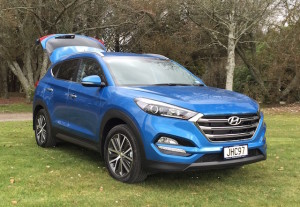 Hyundai Tucson: Like other Hyundais in this part of the world, Tucson’s suspension set-up has been individually tailored to cope with a mix of road surfaces. It’s an evaluation process, finding out which combinations of shock absorbers, springs and anti-roll bars best aid driving dynamics. The Tucson’s might be the best set-up yet. Point the Tucson at any old road and its supple suspension takes it in its stride. It’s a quiet achiever with excellent body control. The cabin blends good quality materials with clear instruments. Line-up: Nine variants, three 2WD and six 4WD, and three engines: 121kW/203Nm 2.0-litre petrol for 2WDs; 130kW/265Nm 1.6-litre turbo petrol, or 136kW/400Nm 2.0-litre diesel for 4WDs.The 2.0-litre engines get a six-speed ‘auto, the 1.6-litre turbo gets a seven-speeder. Priced: $39,990-$63,990.
Hyundai Tucson: Like other Hyundais in this part of the world, Tucson’s suspension set-up has been individually tailored to cope with a mix of road surfaces. It’s an evaluation process, finding out which combinations of shock absorbers, springs and anti-roll bars best aid driving dynamics. The Tucson’s might be the best set-up yet. Point the Tucson at any old road and its supple suspension takes it in its stride. It’s a quiet achiever with excellent body control. The cabin blends good quality materials with clear instruments. Line-up: Nine variants, three 2WD and six 4WD, and three engines: 121kW/203Nm 2.0-litre petrol for 2WDs; 130kW/265Nm 1.6-litre turbo petrol, or 136kW/400Nm 2.0-litre diesel for 4WDs.The 2.0-litre engines get a six-speed ‘auto, the 1.6-litre turbo gets a seven-speeder. Priced: $39,990-$63,990.
LARGE SUV
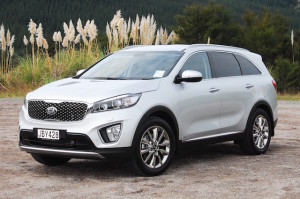 Kia Sorento: If you are after a high-riding family seven-seater, either 2WD or 4WD, you can’t look past the Sorento. It makes a strong case for being the best value-for-money model in its SUV segment. It’s easy to drive, well equipped, has good seats, plenty of room. The layout of controls and instruments is intuitive. It’s reasonably light on its feet and handles well, helped by a brake-based torque vectoring system. This, like rival systems, brakes the inside wheels to smooth progress into and out of bends. There’s also a system on 4WD models that splits drive 50:50 front and rear in slow going over sticky stuff. It automatically unlocks at around 40km/h. Line-up: Seven models, two 2WD petrol, five 4WD diesel, six-speed ‘auto, three engines,: 126kW/225Nm 2.4-litre petrol; 199kW/318Nm 3.3-litre V6 petrol; 147kW/441Nm 2.2-litre diesel. Priced: $49,990-$70,990.
Kia Sorento: If you are after a high-riding family seven-seater, either 2WD or 4WD, you can’t look past the Sorento. It makes a strong case for being the best value-for-money model in its SUV segment. It’s easy to drive, well equipped, has good seats, plenty of room. The layout of controls and instruments is intuitive. It’s reasonably light on its feet and handles well, helped by a brake-based torque vectoring system. This, like rival systems, brakes the inside wheels to smooth progress into and out of bends. There’s also a system on 4WD models that splits drive 50:50 front and rear in slow going over sticky stuff. It automatically unlocks at around 40km/h. Line-up: Seven models, two 2WD petrol, five 4WD diesel, six-speed ‘auto, three engines,: 126kW/225Nm 2.4-litre petrol; 199kW/318Nm 3.3-litre V6 petrol; 147kW/441Nm 2.2-litre diesel. Priced: $49,990-$70,990.
UTILITY
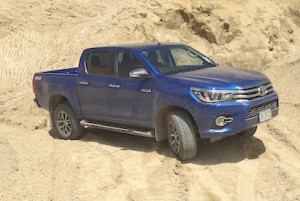 Toyota Hilux: Social media hostility might have forced Toyota to pull its television advertising campaign for the Hilux, but it won’t blunt sales of the ute. Its main rivals do some things better: Mitsubishi Tritron has the cleverest four-wheel-drive system; Nissan Navara has the best cabin and its coil-sprung rear independent suspension plants it, laden or unladen, better on badly surfaced roads; Ford Ranger is more powerful and has a lazier open-road gait, one reason why it remains a best seller; but the new Hilux comes out as the leading allrounder, an easy rider on road, highly flexible off road, thanks partly to impressive rear wheel travel. Line-up: 21 models, nine 2WD, 12 4WD, six-speed manual or auto boxes, one 2.8-litre diesel engine in three states of tune (123kW/343Nm, 130kW/420Nm, 130kW/450Nm), one 175kW/376Nm 4.0-litre petrol V6. Priced: $36,990-$70,490.
Toyota Hilux: Social media hostility might have forced Toyota to pull its television advertising campaign for the Hilux, but it won’t blunt sales of the ute. Its main rivals do some things better: Mitsubishi Tritron has the cleverest four-wheel-drive system; Nissan Navara has the best cabin and its coil-sprung rear independent suspension plants it, laden or unladen, better on badly surfaced roads; Ford Ranger is more powerful and has a lazier open-road gait, one reason why it remains a best seller; but the new Hilux comes out as the leading allrounder, an easy rider on road, highly flexible off road, thanks partly to impressive rear wheel travel. Line-up: 21 models, nine 2WD, 12 4WD, six-speed manual or auto boxes, one 2.8-litre diesel engine in three states of tune (123kW/343Nm, 130kW/420Nm, 130kW/450Nm), one 175kW/376Nm 4.0-litre petrol V6. Priced: $36,990-$70,490.
SPORTS PERFORMANCE
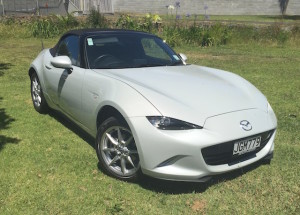 Mazda MX-5: What’s ‘performance?’ Is it turbocharged power and speed with dynamics aided by a package of electronic powertrain gizmos? The rear-drive Mercedes-AMG C 63 and all-wheel-drive Audi RS3 that arrived in 2015 slot right in there. Firecrackers both of them. Or is it a mix of a naturally aspirated engine with modest power, and a light weight and beautifully balanced rear-drive chassis with crisp steering response and few electronic powertrain aids? That’s why the MX-5 spells performance in my book. It’s simply one of the most responsive sporty cars available at any old price. Mazda calls the balancing act ‘Jinba ittai’, a oneness between car and driver. Line-up: three models, two four-cylinder engines, six-speed manual or ‘auto transmissions. 96kW/150Nm 1.5-litre; 118kW/200Nm 2.0-litre. Priced: $40,995-$48,995.
Mazda MX-5: What’s ‘performance?’ Is it turbocharged power and speed with dynamics aided by a package of electronic powertrain gizmos? The rear-drive Mercedes-AMG C 63 and all-wheel-drive Audi RS3 that arrived in 2015 slot right in there. Firecrackers both of them. Or is it a mix of a naturally aspirated engine with modest power, and a light weight and beautifully balanced rear-drive chassis with crisp steering response and few electronic powertrain aids? That’s why the MX-5 spells performance in my book. It’s simply one of the most responsive sporty cars available at any old price. Mazda calls the balancing act ‘Jinba ittai’, a oneness between car and driver. Line-up: three models, two four-cylinder engines, six-speed manual or ‘auto transmissions. 96kW/150Nm 1.5-litre; 118kW/200Nm 2.0-litre. Priced: $40,995-$48,995.
